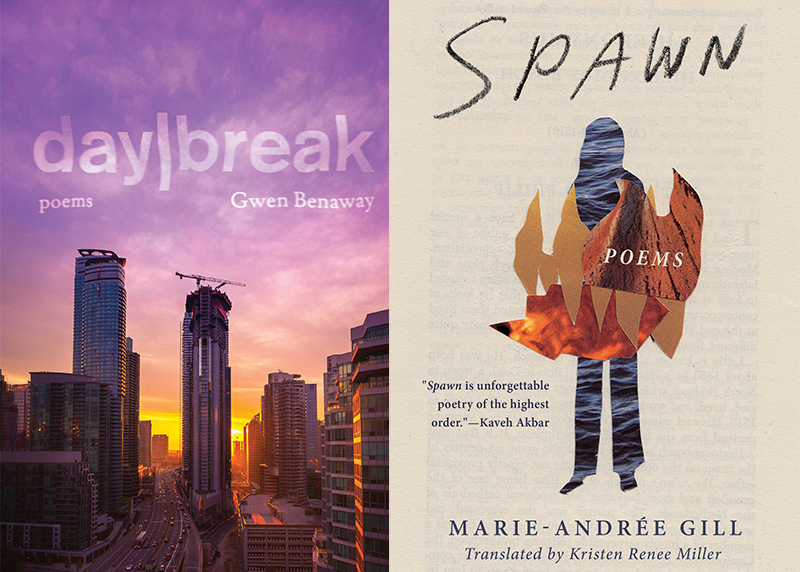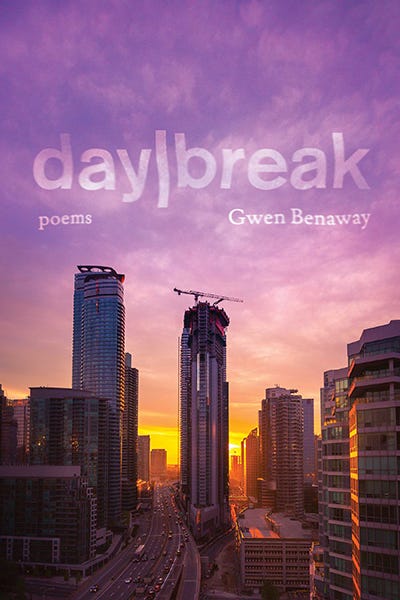
“what is poetry for
if not description?
I am never sure
when I’ve said enough
or need disclaimers.”
— Gwen Benaway, day/break
When Marie-Andrée Gill’s Spawn and Gwen Benaway’s day/break arrived at my house, courtesy Book*hug Press, I was still able to move around the world at will. I read that Kristen Renee Miller, Gill’s translator, lived in Louisville, Kentucky. I had plans to be in Louisville in the fall for my day job. I thought to myself, “Maybe I will email her to see if she would like to meet for an interview while I’m there.”
I wanted to talk with her in person about what she wrote in her translator’s note: “As Spawn’s translator, tasked with rendering the text from one settler language (French) into another (English), my work was delicate and intense.”
“Delicate and intense” would also describe my experience reading her translation of Gill’s spare and precise poetry, all the more so because of the global quarantine.
“Ouananiche remain in the lake, while Atlantic salmon migrate to the sea for part of their life cycle. With the exception of this difference, ouananiche and Atlantic salmon are the same species.” — Marie-Andrée Gill, from Spawn, translated by Kristen Renee Miller
Normally, I would be writing this review from the coffee shop I call “my Saturday office.” I would be drinking orange blossom tea and eating a huge brown sugar cookie. I would be sitting in the back room, where the writers go. I would contribute my rhythm to the percussion of the room. Ensemble for Laptops, №32. [1] Of course, coffee shops are not open now. My Saturday office does offer curbside service, and I take advantage of that sometimes, but it’s the uncomfortable bar stool and disheveled writers I really want, not the tea.
“Excuse me,” we would say to each other. “I just need to reach past you to plug in my laptop.”
“Sure,” we would say to each other. “No problem.”
We would make room.
As an Indigenous trans woman of Anishinaabe and Métis descent, Gwen Benaway writes about the expectations placed upon Indigenous writers: “I am supposed to be weeping / in the pages / instead I live.”

day/break does much more than “[weep] in the pages,” but it certainly makes room for pain (physical, emotional, spiritual, historical). It takes the reader’s face in its hands and gently turns it toward the lived experience of a specific trans woman navigating layers of exile, erasure, and appropriation. The essence of day/break is contained in the title’s forward slash: the line between clarity/light/warmth and coming apart. day/break takes place just past the last moment before everything changed. It’s still in the breaking, not the days after. Yet Benaway’s insistence on naming what can be named and claiming what can be claimed, in this season, makes day/break an uplifting book, despite all the subtle and lasting tragedies it outlines.
day/break refuses to be ashamed of what hurts, of what isn’t enough. day/break explores what can and cannot be contained by words or by a body , “the place where language parts / from meaning.”
Like Gill, Benaway writes in a language foreign to her Indigenous ancestors, a language inextricably entwined, like all languages, with its cultural history, which includes generations of attempts to erase Indigenous people as well as people not included in the conventional gender/sexual binaries. She implores at one point, “[G] ive language / its weary absence / and say nothing,” and she also writes, “I apologize for not failing enough / to be worth saving, / for being raped / but / not beaten, / for writing another book / instead of disappearing.”
Benaway offers no speculation on what comes after the breaking, but day/break suggests that something can come after it — another book, perhaps; another survival — despite a postscript reminiscent of A Midsummer Night’s Dream, which has the speaker “[turning] back” from language/poetry, “reluctant and confused / to life.”
“Reluctant and confused,” perhaps, but fortified now to continue on outside the order that poetry bestows, however momentarily, upon the unspeakable. Fortified like us when we look up from the end of this generous, daring book and find ourselves, for the eternal moment, sequestered in our houses for our own good.
Gill is Pekuakamishkueu, and Spawn takes place on the Mashteuiatsh Reserve in Quebec. Quebec’s settlement caused her ancestors to stay there, on a smaller and smaller piece of land. They are still there today.

I’m Muscogee (Creek). In the 1830s, my ancestors were “removed”[2] from our ancestral homelands in what is currently Alabama and Georgia to Indian Territory, now called Oklahoma. The Dawes Act of 1887 magnanimously “gave” allotments to my great-grandparents’ generation. Often, family members’ allotments were far from each other. The U.S. government was trying to make us start thinking of ourselves as individuals.
In 2003, soon after the Global War on Terror started, I married a soldier, and we lived all over the place. Last year he retired, and we moved back to Oklahoma. It’s what Muscogee people mostly do, eventually, even when we don’t really want to be here.
So being quarantined in Oklahoma does poke a generational bruise for me. I can’t leave, and our family can’t gather, and our tribe can’t gather for ceremonies or anything else. I like the solitude, which is something a Muscogee woman seldom has, and I understand why we must quarantine ourselves. But being told to stay here and not gather … that’s the bruise.
The opening poem of Spawn reads so differently in quarantine:
“We the unlikely
the aftermath
the remains of heart muscle
and black earth
We the territory
in a word”
The book takes the life cycle of the ouananiche salmon in Lake Piekuakami as an overarching metaphor, reflecting on confines — those we choose, those chosen for us, and those we don’t realize we have a choice about. Gill contemplates, in small poems surrounded by lots of white space, the struggle of “spawning” and all it represents (instinct, fulfillment, continuance, more), for a young person just stepping over the threshold into independence.
Reading Spawn from this present confinement, I am struck by the section titled “Adolescence,” in which young people do the things young people sometimes do: Kiss. Share a bong. Touch. Deeply desire each other’s presence. Wander around in groups. All of these things that are much too dangerous for anyone to do right now. Young bodies, less susceptible to severe cases of the pandemic virus, are portrayed all over the internet as dangerously unidentifiable asymptomatic carriers, a peril to their elders. Media fixated on young people partying on beaches, just before the quarantine began. They didn’t know how bad it would be. Nobody knew. Still, they were judged as if they should have known. Graphs were created to show the deadly effects of their good time.
Gill’s rendering of the spawning of newly-independent youth was, before the pandemic, something more than wistful and nostalgic. Mid-pandemic, it reads like something that happened so long ago it doesn’t seem real, though you know it is … Like when a cousin of my mother’s generation talks about being in an iron lung during the polio epidemic. Or when kids in 1950s movies went barreling down unlit back roads in cars with no seatbelts.
It was always important for Gill to chronicle the carvings in trees, the rubbing of balloons in hair, the online and outside hijinks, the “chaos” of “humanity’s bright future.” It was always important, but now it is more important.
“Perhaps we’ve forgotten that the body, yes the body, finds a desolate kind of beauty once exposed.” –Gill
In these quietly audacious collections, both Gill and Benaway expose the body: what it contains and confines, as well as how it becomes a vehicle for connection and movement. I often dismiss the body as an inconveniently delicate necessity of life. However, reading these poems at a time when masks cover faces and people must keep their bodies far apart for safety, I see that the body — “yes, the body” — matters terribly, in its breaking and in its spawning, when it’s well and when it’s waiting. Both of these collections chronicle the last moments before the body became what it will be in the unimaginable future.
“yes the body”: A Quarantined Review of Spawn and day/break was originally published in Anomaly on Medium, where people are continuing the conversation by highlighting and responding to this story.
